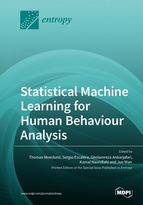Statistical Machine Learning for Human Behaviour Analysis
A special issue of Entropy (ISSN 1099-4300). This special issue belongs to the section "Statistical Physics".
Deadline for manuscript submissions: closed (31 August 2019) | Viewed by 75533
Special Issue Editors
Interests: computer vision; image processing; machine vision; pattern recognition; visual analysis of peoples' whereabouts; surveillance; traffic monitoring
Special Issues, Collections and Topics in MDPI journals
Interests: human behaviour analysis; pattern recognition; machine learning
Special Issues, Collections and Topics in MDPI journals
Interests: machine learning; computer vision; human–computer interaction; emotion recognition; deep learning; human behaviour analysis
Special Issues, Collections and Topics in MDPI journals
2. Research Department at Milestone Systems A/S, Copenhagen, Denmark
Interests: Action Recognition; Pattern Recognition; Machine Learning
Special Issue Information
Dear Colleagues,
Human Behaviour Analysis has introduced a number of challenges in various fields, such as applied information theory, affective computing, robotics, biometrics and pattern recognitions. This Special Issue focuses on novel vision-based approaches, which mainly belong to broader categories, such as computer vision and machine learning. The above topics fall, mainly, under categories related to computer vision and machine learning, where the theoretical advancements and practical developments usually benefit from the contributions brought by other areas of research in the relevant domains of science and technology, which is due to the multidisciplinary nature of the task.
We solicit submissions on the following topics:
- Information theory based pattern classification
- Biometric recognition
- Multimodal human analysis
- Low resolution human activity analysis
- Face analysis
- Abnormal behaviour analysis
- Unsupervised human analysis scenarios
- 3D/4D human pose and shape estimation
- Human analysis in virtual/augmented reality
- Affective computing
- Social Signal Processing
- Personality computing
- Activity recognition
- Human tracking in wild
- Application of information-theoretic concepts for human behaviour analysis
Prof. Dr. Thomas Moeslund
Prof. Dr. Sergio Escalera
Prof. Dr. Gholamreza Anbarjafari
Prof. Dr. Kamal Nasrollahi
Dr. Jun Wan
Guest Editors
Manuscript Submission Information
Manuscripts should be submitted online at www.mdpi.com by registering and logging in to this website. Once you are registered, click here to go to the submission form. Manuscripts can be submitted until the deadline. All submissions that pass pre-check are peer-reviewed. Accepted papers will be published continuously in the journal (as soon as accepted) and will be listed together on the special issue website. Research articles, review articles as well as short communications are invited. For planned papers, a title and short abstract (about 100 words) can be sent to the Editorial Office for announcement on this website.
Submitted manuscripts should not have been published previously, nor be under consideration for publication elsewhere (except conference proceedings papers). All manuscripts are thoroughly refereed through a single-blind peer-review process. A guide for authors and other relevant information for submission of manuscripts is available on the Instructions for Authors page. Entropy is an international peer-reviewed open access monthly journal published by MDPI.
Please visit the Instructions for Authors page before submitting a manuscript. The Article Processing Charge (APC) for publication in this open access journal is 2600 CHF (Swiss Francs). Submitted papers should be well formatted and use good English. Authors may use MDPI's English editing service prior to publication or during author revisions.
Keywords
- human behaviour analysis
- machine learning
- information theory
- biometrics
- emotion recognition











